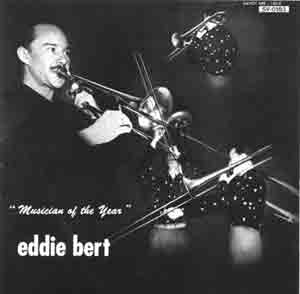
EDDIE BERT is a dedicated musician, dedicated to music and to entertainment
both Entertainment in music means the playing of happy sounding music to him,
music to which people can clap their hands, literally or figuratively. And
this is as good an explanation as can be offered for part of his style-the
swinging, rollicking mood that he affects on up-tempo: the insinuating, lilting
mood that he achieves on ballads.
Achieves is a better choice of words, for there is nothing affected about
the smile which his horn projects. "I like to play it," he explains,
"it's the kind of music I grew up with.' That was the music played by
Jimmie Lunceford and Count Basie and the other swinging bands of the late
thirties and early forties, and decidedly not the music played by most of
the bands with whom Eddie has been in the last ten years with the one notable
exception of Red Norvo's little band.
Another side of the style is due to Eddie's delight in the roll and flow of
reed instruments, especially the tenor sax, which instrument he tries to emulate
in his own playing. The third side, or slide, is most evident in his own records,
especially on those tunes which he has written himself. For he writes as if
he were actually blowing a chorus, "only it has more form, clarity and
finesse." And within this structuring, the lilt and swing, the roll and
flow, of his trombone are shown to their best advantage. Exhibits A and B
an: two recently released sides, Mol Shaja (Molly, his wife, and his two daughters
Sharon and Jane make up this title) and First Day of Spring, both of which
he wrote.
Both these sides, two more which appeared at the same time and four more which
are
to be released this month, contain the last two elements of Eddie's thinking
and playing
of today. The first is sound, the sound of guitar (Sal Salvador) and trombone,
producing
a handsome blend because of their similarity in sound and achieving the subtle
newness
that Eddie would like to produce for himself. The other element is distaste
with gim-
micks, a belief in sincerity. Which belief expresses itself in his words-"To
tell a story (and
that's what I'm doing) yon don't and can't use gimmicks. You use what's inside
you"-
and in his playing and leading, which allows for the ultimate in self-expression
both for
himself and the others in his group. This in total is the Eddie Bert who is
"no pioneer."
but is a tasteful, colorful and thoughtful musician whose youth and stature
assure him of
an important place in the jazz of today and tomorrow.-
BILL Coss "
METRONOME
FOR the third time in a row (Billy Taylor and Johnny Smith occupied this space
previously) this series is devoted to a thirty- year-old musician: for the
second time (as in the case of Johnny Smith) it deals with a self-taught musician.
Eddie Bert was born in Yonkers. New York in 1923. When he was sixteen (1939).
He formed his first jazz group with neighbor Shorty Rogers and a local rhythm
section, a group which only played a few jobs "because the people didn't
know what to make of it."
By that year, Eddie was an avid Lunceford fan. following that band about as
well as attending as many of the Count Basie rehearsals as possible. It was
from these two hands that he drew most of his early jazz inspiration as well
as his one small bit for training on his horn.
The lessons were from Benny Morton. the Count's great trombonist of the time.
The inspiration was from Trummy Young, Lunceford's trombonist, about whose
"big band playing," Eddie still raves, and from Lester Young, who
was also with the Count.
He lists the tenor sax as his favorite instrument, strangely enough. He took
six months of lessons on it, and he has no idea why or how he became a trombonist.
But his penchant for the tenor explains his trombone style somewhat, which
is predicated on the roll and flow of that reed instrument.
Eddie's first professional job in the big time was with Sam Donahue's band,
in and around Boston, beginning in March of 1940. His favorite job, and he
has been with most of the country's bands at one time or another, was with
the Red Norvo group which featured Shorty Rogers, Specs Powell and Clyde Lombardi.
"One continual ball," is the way that he describes it. Never recorded,
because it played during the record ban, the group remained almost intact
from 1941 to 1943.
After leaving Red, Eddie played only in big bands, with the exception of some
time with Herbie Fields. He worked his way through the orchestras of Charlie
Bar-net, Woody Herman, Stan Kenton, Boyd Raeburn, Benny Goodman, Elliot Lawrence,
etc. He thinks of this time as having been largely wasted as far as his personal
success is concerned. With Red Norvo, as he points out, he won the number
four place in the METRONOME All Star Poll. In 1953, he didn't even show on
the Poll.
He is presently studying arranging at the Manhattan School of Music, playing
gigs around New York and making records for Discovery. His personal plans
hinge on these records. "If they make any showing," he says, "I'll
try to organize a steady group and do something for music and myself."


In 1955, Eddie Bert was named Metronome Musician of the Year and released the following recording with the same name with Hank Jones, Piano, Wendell Marshall bass and Kenny Clarke Drums, recorded May 31, 1955.